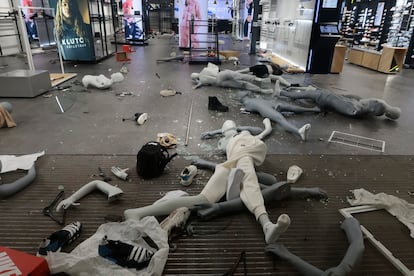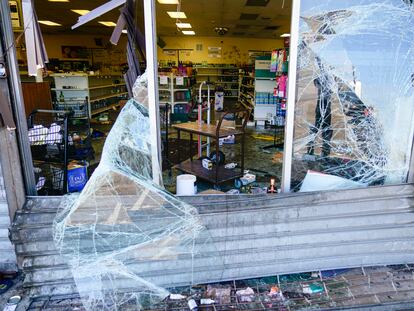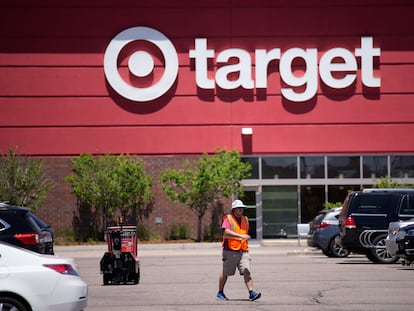Smash-and-grab robberies wreak havoc on US stores
Organized retail crime is skyrocketing, forcing major chains to close locations and causing losses of up to $112 billion

A group of young people stormed businesses in downtown Philadelphia last Wednesday. Dozens of stores, including Apple, Foot Locker and Lululemon, were ransacked. The police took action and made dozens of arrests, but in recent months, similar incidents have been happening again and again in large cities across the United States. The phenomenon has even been given a name: “smash-and-grab robberies.” On many occasions, the attacks are carried out with total impunity. The robbers enter in broad daylight, when the stores are still open, rush past the helpless employees and escape before the police arrive.
The same day of the smash-and-grab robberies in Philadelphia, the U.S. retail giant Target announced the definitive closure of nine establishments due to the rise in violence and robberies. The day before, on Tuesday, the U.S. National Retail Federation (NRF) warned of the rise of organized crime against stores. It reported that financial losses associated with theft reached $112 billion in 2022, a record high.
Social media is full of videos of retail robberies, especially on the West Coast, with the metropolitan areas of Los Angeles and San Francisco/Oakland the hardest hit by the wave of robberies. On August 1, a group of between 30 and 50 hooded people broke into the Nordstrom store in Topanga, northeast of Los Angeles, and took luxury products such as designer handbags worth between $60,000 and $100,000, according to police. The thieves used bear repellent spray to incapacitate the security guards at the store. Footage of how the assailants destroyed everything in the store went viral.
Breaking News: A smash-and-grab robbery shocks LA! Police are seeking up to 30 suspects after a major heist at a Nordstrom store inside Westfield Topanga Mall around 4:15 pm on Saturday (8/12)pic.twitter.com/v5i1B0fN7Z
— Los Angeles Magazine (@LAmag) August 13, 2023
Eric Nordstrom, CEO of Nordstrom, was asked about the incident days later at a conference with analysts. “Certainly what happened in our Topanga store is disturbing to all of us. But the loss is a concern. Losses from theft are at historic highs. I’d say we find it unacceptable and [it] needs to be addressed. That being said, while it’s unacceptable, it is within our plans. We have not seen continuing rising of shrinkage that has exceeded what we planned,” he said.
Despite Nordstrom’s assurances, losses from thefts are exceeding most retailers’ forecasts. “Q2 profitability was short of our expectations due in large part to the impact of elevated inventory shrink, an increasingly serious issue impacting many retailers,” said Lauren Hobart, the CEO of Dick’s Sporting Goods, in their second quarter earnings call. Hobart said “organized retail crime and theft in general” was an “increasingly serious issue impacting many retailers.” “The number of incidents and the organized retail crime impact came in significantly higher than we anticipated,” added Navdeep Gupta, the CFO of Dick’s Sporting Goods, which has more than 850 stores throughout the country and an annual turnover of more than $12 billion.
Foot Locker CFO Michael Baughn also warned about the rise in robberies in the company’s earnings call. “We continued to see elevated shrink levels.” In the retails sector, euphemisms such as shrinkage or unknown loss are often used. These terms cover losses due to deterioration and theft, both from within and outside the company. But more and more companies are preferring to call the phenomenon by its name. When announcing the closure of nine stores (three in Portland, three in the San Francisco and Oakland area, two in Seattle and one in New York), Target stated: “We cannot continue operating these stores because theft and organized retail crime are threatening the safety of our team and guests.”
Previously, in the company’s earning call in August, Target CEO Brian Cornell warned that the company “continues to face an unacceptable amount of retail theft and organized retail crime.” “And unfortunately, safety incidents associated with theft are moving in the wrong direction.” According to Cornell, during the first five months of 2023, Target stores saw a 120% increase in theft involving violence or threats of violence.
Waves of thefts
These types of smash-and-grab robberies, especially the violent ones, have set off social alarm. But the phenomenon is not entirely new. The wave tends to happen quickly and seasonally. California saw an intense surge towards Christmas 2021. This prompted the governor, Democrat Gavin Newsom, to pledge to invest about $300 million in security over three years. Authorities focused on increasing police presence in shopping centers and businesses that had been ransacked, such as jewelry stores.
The five cities or metropolitan areas most affected by organized retail crime are Los Angeles, San Francisco/Oakland, Houston, New York and Seattle, according to the NRF. The first two areas are in California. In mid-September, Newsom recalled that he still had about $267 million in funding from the investment pledge, which he will give to 55 police departments and sheriff’s offices. The money is intended to finance investigation teams and reinforce the number of police in the fall, the peak commercial season.
Conservative sectors argue that the rise of robberies in California is the result of the 2014 approval of Proposition 47, which reduced the penalty for property crimes if the guilty party did not have a criminal record. The measure was a bid to ease the pressure on California’s overcrowded prisons, which have the biggest population in the country.
Activists in favor of penal reform, such as the American Civil Liberties Union (ACLU), argue that Proposition 47 is not responsible for the rise in smash-and-grab robberies. Under California law, anyone who steals items worth more than $950 has committed a felony. In Washington state, where similar episodes have also been recorded, the limit is even lower, $750. Texas and other entities have a higher ceiling, of up to $2,500.
Increase in property crimes
While Republicans argue that California is soft on crime, the Democrat state says that no one who commits a smash-and-grab robbery goes unpunished. Last year, 2,313 property crimes were committed, an increase of 6.2% compared to 2021. California State Attorney Rob Bonta tried to put an optimistic twist on the numbers, arguing last summer, that it was still far from the historic high of 6,800, which was documented in 1980.
The rise of robberies is not limited to California. “Retailers are seeing unprecedented levels of theft coupled with rampant crime in their stores, and the situation is only becoming more dire,” said NRF Vice President for Asset Protection and Retail Operations David Johnston in a statement. “Far beyond the financial impact of these crimes, the violence and concerns over safety continue to be the priority for all retailers, regardless of size or category.”
Businesses have recorded a dramatic rise in financial losses associated with theft. In 2022, these losses represented $112.1 billion, up from $93.9 billion in 2021, according to the 2023 National Retail Security Survey published this week by the NRF. The figure includes both external theft and theft from employees. The study also warned that with the increase in violence, more retailers are opting for a “hands-off approach in the apprehension of shoplifters.” Forty-one percent of respondents said that no employees are authorized to stop or detain thieves.
Retailers, meanwhile, are strengthening their security teams, hiring more security guards, storing merchandise of increasingly less value in locked boxes and blocking and limiting entrances and exits to stores to prevent robberies. But this has not proven to be enough. As a direct result of crime, 30% of companies have reduced or altered in-store product selection, 45% have reduced operating hours, and 28% have been forced, like Target, to opt for the most drastic measure: closing a store location. That however is not as drastic as what former U.S. president Donald Trump proposed last Friday at an event in California: “If you rob a store, you can fully expect to be shot as you are leaving that store.”
Sign up for our weekly newsletter to get more English-language news coverage from EL PAÍS USA Edition
Tu suscripción se está usando en otro dispositivo
¿Quieres añadir otro usuario a tu suscripción?
Si continúas leyendo en este dispositivo, no se podrá leer en el otro.
FlechaTu suscripción se está usando en otro dispositivo y solo puedes acceder a EL PAÍS desde un dispositivo a la vez.
Si quieres compartir tu cuenta, cambia tu suscripción a la modalidad Premium, así podrás añadir otro usuario. Cada uno accederá con su propia cuenta de email, lo que os permitirá personalizar vuestra experiencia en EL PAÍS.
¿Tienes una suscripción de empresa? Accede aquí para contratar más cuentas.
En el caso de no saber quién está usando tu cuenta, te recomendamos cambiar tu contraseña aquí.
Si decides continuar compartiendo tu cuenta, este mensaje se mostrará en tu dispositivo y en el de la otra persona que está usando tu cuenta de forma indefinida, afectando a tu experiencia de lectura. Puedes consultar aquí los términos y condiciones de la suscripción digital.
More information
Últimas noticias
Rowan Atkinson tops Netflix at 70: ‘He’s as funny as ever’
Israeli recognition of Somaliland stirs up the Gulf
Tiger Woods turns 50: Will he continue playing on the PGA Tour or take a back seat?
The surreal journey of James Nnaji, the Barcelona youth player selected in the NBA Draft who ended up in the NCAA
Most viewed
- Oona Chaplin: ‘I told James Cameron that I was living in a treehouse and starting a permaculture project with a friend’
- Reinhard Genzel, Nobel laureate in physics: ‘One-minute videos will never give you the truth’
- Sinaloa Cartel war is taking its toll on Los Chapitos
- Why the price of coffee has skyrocketed: from Brazilian plantations to specialty coffee houses
- Chevy Chase, the beloved comedian who was a monster off camera: ‘Not everyone hated him, just the people who’ve worked with him’










































